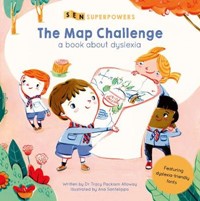Dr Tracy Packiam Alloway


About Author
Dr Tracy Alloway is a TEDx speaker, psychologist, and author of 13 books.
Her most recent books in the SEN Superpower series (published by QED) celebrate Memory Superpowers in children with Dyslexia, Autism, ADHD, and Anxiety.
Several media outlets have talked about it as "creating books that give children with learning disabilities superpowers and voices to spread awareness."
She has dedicated her research to understanding the role of working memory, the ability to remember and process information, in education.
One of the groundbreaking findings from her research is that working memory deficits are more closely linked to lower academic attainment than IQ, especially in children with learning needs. She also found that working memory is not greatly affected by the home environment of the child, which can level the playing field when it comes to learning potential.
Her research has been recognized by various awards (by the British Science Association among others), and has been featured on BBC, Good Morning America, the Today Show, Forbes, Bloomberg, The Washington Post, and Newsweek, and many others.
See her website (www.tracyalloway.com) for further information on her research and media coverage of it.
Author link
Interview
THE MAP CHALLENGE: A BOOK ABOUT DYSLEXIA (SEN SUPERPOWERS)
QED PUBLISHING
OCTOBER 2019
QED PUBLISHING has created an inclusive range of picture book texts for children aged 5-7 years, aimed at exploring SEN 'superpowers', including dyslexia, autism, ADHD and anxiety.
The books are aimed at SEN children who live with these challenges and also to help all children understand the challenges and to understand the special abilities of children with SEN.
We spoke with the series' creator and writer, DR TRACY PACKIAM ALLOWAY, about the SEN SUPERPOWERS books:
Q: What is your background in working with children with Special Educational Needs (SEN)?
A: My Phd is in psychology and the majority of my research has been in educational settings. I am grateful to the thousands of teachers and parents who have contacted me and taken me beyond the world of theory and data to see the classroom from their perspective. Their struggles and successes have inspired and motivated me to keep searching for answers to find out what makes the difference for students.
Q: Why did you feel it was important to have this series of illustrated stories - SEN Superpowers - and how did you get involved in the project?
A: I wanted to shift the focus and talk about a strength-based model of learning needs. While it is important to create awareness of learning needs, I wanted the make the stories about what they CAN do - and put it in a everyday context so the children could see themselves in that situation.
Q: Have you written other books for children?
A: Yes - I recently published a book for middle school children on what poor working memory looks like from a child's perspective and tips for how to boost it.
Q: There has been a lot of work in schools to support SEN practitioners - but how well are schools managing in explaining
special educational needs to children in class?
A: I am fortunate enough to work with many fantastic schools in the US, the UK (I am a patron of a school that supports children with dyslexia) and all around the world, so I get to see first-hand the wonderful work that educators are doing. I love that they invite me to be part of their journey.
Q: Can you tell us a bit about the SEN SUPERPOWERS books and what you want the stories to achieve?
A: These books turn learning disabilities into superpowers. The goals are two-fold:
1) to create awareness so that other students can better understand the behaviors of children of with learning needs;
2) so that the children with learning needs can see their superpowers, instead of just focusing on their areas of needs.
Q: Which special needs did you want to explore in these stories, and why?
A: I selected them based on my areas of research expertise. I have been able to work directly with these populations, hear the parents' perspectives of raising a child with learning needs, talk to the teachers, and publish scientific research on how they learn.
Q: Is there one area of SEN that you feel particularly strongly about or have particular experience in working with?
A: No, I have been very fortunate to work with different groups and I learn something from each one.
Q: Why did you decide to include the notes at the back of the book for teachers and parents?
A: As a psychologist and an author, I have written many books - educational books, text books, popular science books, and in an instances, the most consistent feedback is that readers enjoyed having a take-away, a practical application of the science. So I applied that same idea to this book series - I wanted parents and teachers to first of all understand why these children were behaving in these ways (and it's not because they were being naughty, or difficult, etc; but because their brain is wired differently); and secondly, I wanted the parents and teachers to have practical ways to support their unique ways of learning.
Q: How would you like the books to be used in class?
A: Currently I have been invited to do book readings in schools across the US and I love being able to interact with the students. I would love if schools would continue this by reading the books to the children and asking them to reflect on how they can use their memory superpowers in the classroom.
Q: Are you planning to write more books in the series, and if so what will they cover?
A: Oh yes! Stay tuned as I can't share any spoilers ;)
REVIEW OF SEN SUPERPOWERS
The Map Challenge - part of the SEN Superpowers series from QED - is a highly accessible story which takes into account the worries, fears and difficulties that children with dyslexia may have. The book is reader-friendly and the pictures and text suit all readers, including those with dyslexia. The story is relatable and helps the reader to understand that children with dyslexia have special strengths that can overcome their difficulties. This is a very clear story that helps pinpoint certain difficulties of dyslexia, and how children can learn strategies to allow them to overcome and build confidence when approaching tasks.
Sammy is a young boy who is on his first day of scout camp. He is asked to be the navigator of his group of children for the first activity by reading a map. Sammy is filled with dread as he finds directions and reading very tricky. As they go on their way, other children take over reading the map, whilst Sammy starts to pay attention to landmarks around him. When the children get into difficulty and become lost, Sammy is able to lead them back to the Scout camp by remembering the places and things he has seen and remembered along the way.
Sammy's character is very relatable to children who I have worked with, and who would really panic and become distressed about the task of reading a map or instructions. The way that the other children took over the navigation was also true to what would usually happen. I liked that Sammy was able to speak up in the end and show how he had skills that the other children had overlooked, and how he was able to commit pictures to his memory.
This book is easy to share with all ages of children, and provides a good talking point to introduce how some children have difficulties but also strengths. This can boost the confidence of children who feel that reading/writing is a struggle - and give an insight to what they have special skills in.
The text and layout of the story was clear to follow, and the colouring on the page was soft in contrast. Lots of pastel and muted colours allowed the pictures to be easily viewed without harsh contrasts.
I would use this book in class to introduce differences and how dyslexia can be a strength in different ways, and use the comprehension questions at the back to discuss the feelings of children who find learning and activities difficult. Working with parents and children 1:1, the book could be used for the child to share worries and talk about strategies with their parents about what they find difficult and realise their strengths also. The helpful talking points and key information at the back of the book are a helpful first step into sharing with a child their views and how to possibly help them. The tips for boosting memory skills at the back of the book are accessible for teachers and parents.
I feel that this book will appeal to students, parents, teachers and school staff. It's really important to recognise difficulties for pupils with dyslexia, but also to recognise the strengths of the pupil, and different ways of them learning effectively - such as kinaesthetic and moving around to visually commit things to memory. It's a lovely little book with a strong message, and good talking points to consider after the story.
24 pages / Ages 5-7 years / Reviewed by Katherine Louisa Hutchings, teacher
 The Map Challenge: A Book about Dyslexia
The Map Challenge: A Book about Dyslexia
